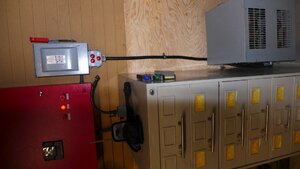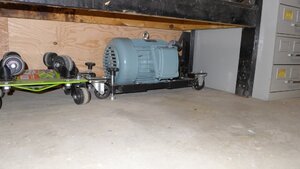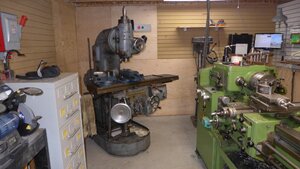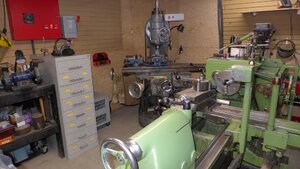Hello,
After trolling this site for awhile I thought I would show what I have been up to. Last summer I toke a chance and purchased a basket case Fritz Werner mill. Over the last six months a machinist friend and I have gone over it and checked it out and cleaned it. When we could not find any major mechanical issues with it other then the rapid traverse motor was missing (and still is) I decided to build a rotary phase converter (RPC) and a 240 to 440V transformer to get it running. Once I had the crude RPC running to supply power to the motor I found that the previous owner have made some changes to the wiring and bypassed the brake, reversing switch and the start switch. Decided that it was easier to tear it all out and rewire it and add stop and start switches closer to the operating controls. I then finished the RPC and fine tuned it. Everything now works on the mill but there are a few issues to resolve and whether to put the rapid traverse motor in. I want to use the mill for awhile and then decide if the machine is worth putting more money and time into it. Doubt that I will give this a full restoration just try and get that awful paint job off it and leave it at that. I have attached a few pictures of the milling and the RPC .






After trolling this site for awhile I thought I would show what I have been up to. Last summer I toke a chance and purchased a basket case Fritz Werner mill. Over the last six months a machinist friend and I have gone over it and checked it out and cleaned it. When we could not find any major mechanical issues with it other then the rapid traverse motor was missing (and still is) I decided to build a rotary phase converter (RPC) and a 240 to 440V transformer to get it running. Once I had the crude RPC running to supply power to the motor I found that the previous owner have made some changes to the wiring and bypassed the brake, reversing switch and the start switch. Decided that it was easier to tear it all out and rewire it and add stop and start switches closer to the operating controls. I then finished the RPC and fine tuned it. Everything now works on the mill but there are a few issues to resolve and whether to put the rapid traverse motor in. I want to use the mill for awhile and then decide if the machine is worth putting more money and time into it. Doubt that I will give this a full restoration just try and get that awful paint job off it and leave it at that. I have attached a few pictures of the milling and the RPC .






